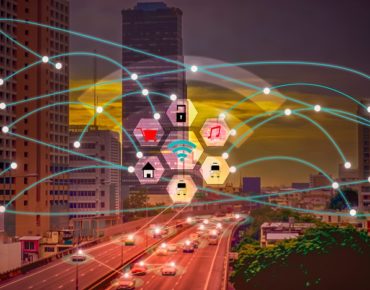Massive IoT Initiative: Securing the Smart City

According to Microsoft, one particular type of project accounts for close to one quarter of all global IoT initiatives: smart-city projects. In a 451 Research report from February 2020, analyst Johan Vermij notes that escalating interest in smart cities has led to the current situation, in which smart cities now comprise 23 percent of IoT projects on a worldwide basis—making them what Vermij describes as the “number one IoT vertical.” In fact, in Microsoft’s fourth year of the company’s “IoT in Action” events in Amsterdam earlier this year, the tech firm gave smart cities the dedicated focus for the first time.
As hyperconnected smart cities have become increasingly key to whether urban areas function smoothly or not, researchers have investigated the role of smart IoT edge devices and edge computing. One study on edge-computing-enabled smart cities—written by senior members of the Institute of Electrical and Electronics Engineers (IEEE)—stated that edge technology is “viable for realizing real-time smart cities advancements.” Yet after deriving five parameters—context awareness, scalability, sustainability, caching, and security—for rigorous evaluation, the researchers determined that “security has considerable importance among the other factors and thus must be implemented in the design of smart applications.”
This focus on security is not always a given with edge computing and devices, which is why it’s important that city IT departments use a software-defined perimeter (SDP) client to create truly secure, hyperconnected smart cities. When it comes to smart cities, security is not something that should be left to chance. The sheer volume of devices and data in cities reveals the security risks inherent in metropolitan areas if proper precautions aren’t taken: by 2025, experts predict we’ll have around 80 billion smart devices (with an exploitable Internet connection), and urban areas are expected generate 180 zettabytes in the next five years.
While cities need smart edge devices to help them navigate their numerous challenges and complexities, they also need edge computing to be secure. Edge devices are indispensable in their ability to, as the IEEE study states, overcome the “inherent limitations of high latency, non-context-aware behavior, and no support for mobility” of standard cloud computing, which “poses serious limitations on its use in real-time smart environments.” But SDP software can ensure that smart cities are equipped with secure connectivity—not only from datacenters but from the cloud to the edge.
Securing the Edge
Let’s look at how an SDP client can achieve such a high level of security for smart-city projects that utilize smart IoT edge devices. The first point is that SDP software ensures that smart IoT edge devices must abide by the software’s “zero trust” architecture. This means the devices can only retrieve the exact applications that IT has authorized them to access, whether the application is in the datacenter or the cloud. The alternative, which is what happens without an SDP client, is that edge devices can access the whole network without restrictions. Network-level access isn’t secure enough for smart-city environments, which is why SDP only allows access at the application level. This approach quashes the ability for hackers to make lateral attacks, and ultimately leads to exactly what smart cities require in terms of security: an environment that’s best described as “secure by default.”
Some other specific benefits of using an SDP client with smart edge devices that city IT directors will appreciate include:
- Direct data transport. With the help of encrypted micro-tunnels plus public key authentication, SDP achieves secure connectivity as data channels directly from smart IoT edge devices to their destination in the cloud or on-premises location.
- Invisibility to hackers. Using an enhanced user datagram protocol (UDP) that features randomly generated ports, some SDP software is able to make micro-tunnels undetectable to unauthorized parties.
- Easy to manage and configure. With connection in seconds, easy integration with networking infrastructure, and no need to rely on appliances, SDP software avoids many common problems—particularly when compared with virtual private networks (VPNs) and their inherent troubles with not only security but configuration and management.
- Improved performance. With SDP, it’s possible to configure tunnels to link edge devices with edge hubs on hardware—and IT can ensure that the tunnels are highly available, and provide built-in failover.
Smart cities need smart IoT edge devices to help them face the challenges of metropolitan areas, but they need more than this solution to achieve secure connectivity. Putting an SDP client in the mix can give smart devices the security that today’s smart cities require to address their heavy challenges.
Don Boxley is a DH2i (www.dh2i.com) co-founder and CEO. Prior to DH2i, Boxley spent more than 20 years in management positions for leading technology companies. Don earned his MBA from the Johnson School of Management, Cornell University.











